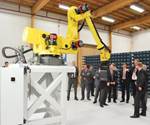Will TPCs reshape commmercial aircraft?
HPC's editor-in-chief Jeff Sloan asks, How much of the next generation of commercial aircraft primary structure will be made with thermoplastic composites?
As an editor who reports on and for the composites industry, I usually go to a trade show with two primary goals: First, to discover as much information as possible about new and emerging products and technologies that might help our readers do their jobs better; second, to look for macro trends and themes that are shaping the composites community. Occasionally, however, I find myself at the super-macro level, struck by themes that reach beyond the horizon and portend profound change to come.
And so it was that I found myself, on the last day of the JEC Composites Show (March 29-31, Paris), after three very busy days, asking this question: How much of the next generation of commercial aircraft primary structure will be made from thermoplastic composites?
This query did not come out of the blue. Thermoplastic composites (TPCs) were emphasized by many companies at this year’s JEC Paris show, and there was some discussion of Airbus, which has been assessing TPC use in structures currently made with thermoset composites. Layered over this was the Airbus A30X, the company’s next-generation single-aisle, destined to succeed the forthcoming, re-engined A320neo.
Might Airbus be looking at extensive use of TPCs in the A30X? Possibly. The plane, at last check, penciled in for a 2030 introduction (thus, my “beyond the horizon” reference), has time to await the TPC research, developmental steps and the fine-tuning that is certain to come over the next several years. In the meantime, thermoplastics have earned their way into the wing leading edges of the Airbus A330/340 and the Airbus A380, the vertical tail of the Gulfstream G650 business jet and other structures. (For a update on ongoing efforts with aerospace TPCs, click on Ginger Gardiner’s timely report, “Thermoplastic composites: Primary structure?” under "Editor's Picks" at right.)
Here in the U.S., Boeing is busy deciding how it should proceed with a replacement for its single-aisle 737. Re-engining is apparently not a consideration, thus a new plane is in order. The question is where and how a 737 replacement might employ composites. Boeing currently produces about one 737 a day, a pace that cannot be met by the fiber placement technology used on the 787. Out-of-autoclave materials and processes are promising in this regard because they offer quicker cycle times. And quicker still are thermoplastics, but how ready are they for application in commercial aircraft structure?
Probably more ready than many of us realize. Until now, use of TPCs in commercial aircraft outside the passenger cabin has been limited and tentative, but successful all the same. Could we stand at the cusp of a new era of ambitious use of TPCs in aircraft primary structure? One that could, again, as thermoset composites have, reshape the commercial aircraft industry?
Related Content
-
Mallinda launches Vitrimax VHM resin for complete composites recyclability
Vitrimax VHM enables “infinite” recyclability, self-healing and tunable properties, reducing manufacturing waste and supporting sustainability for high-performance industries.
-
RWC delivers composite frac plugs for downhole environments
Filament-wound fiberglass/epoxy frac plug billets, developed as part of a contract with an oilfield service company, address the very demanding performance needs of oil and gas.
-
Super Resin Inc. highlights plant-based epoxy resin, foam core
Eco-friendly resin system using glycol lignin offers an eco-friendly option for CFRP structures and components, and core materials.
















